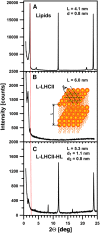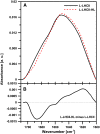Molecular architecture of plant thylakoids under physiological and light stress conditions: a study of lipid-light-harvesting complex II model membranes
- PMID: 23898030
- PMCID: PMC3723618
- DOI: 10.1105/tpc.113.113076
Molecular architecture of plant thylakoids under physiological and light stress conditions: a study of lipid-light-harvesting complex II model membranes
Abstract
In this study, we analyzed multibilayer lipid-protein membranes composed of the photosynthetic light-harvesting complex II (LHCII; isolated from spinach [Spinacia oleracea]) and the plant lipids monogalcatosyldiacylglycerol and digalactosyldiacylglycerol. Two types of pigment-protein complexes were analyzed: those isolated from dark-adapted leaves (LHCII) and those from leaves preilluminated with high-intensity light (LHCII-HL). The LHCII-HL complexes were found to be partially phosphorylated and contained zeaxanthin. The results of the x-ray diffraction, infrared imaging microscopy, confocal laser scanning microscopy, and transmission electron microscopy revealed that lipid-LHCII membranes assemble into planar multibilayers, in contrast with the lipid-LHCII-HL membranes, which form less ordered structures. In both systems, the protein formed supramolecular structures. In the case of LHCII-HL, these structures spanned the multibilayer membranes and were perpendicular to the membrane plane, whereas in LHCII, the structures were lamellar and within the plane of the membranes. Lamellar aggregates of LHCII-HL have been shown, by fluorescence lifetime imaging microscopy, to be particularly active in excitation energy quenching. Both types of structures were stabilized by intermolecular hydrogen bonds. We conclude that the formation of trans-layer, rivet-like structures of LHCII is an important determinant underlying the spontaneous formation and stabilization of the thylakoid grana structures, since the lamellar aggregates are well suited to dissipate excess energy upon overexcitation.
Figures










Similar articles
-
A Key Role of Xanthophylls That Are Not Embedded in Proteins in Regulation of the Photosynthetic Antenna Function in Plants, Revealed by Monomolecular Layer Studies.J Phys Chem B. 2016 Dec 29;120(51):13056-13064. doi: 10.1021/acs.jpcb.6b10393. Epub 2016 Dec 15. J Phys Chem B. 2016. PMID: 27976589
-
Dithiol oxidant and disulfide reductant dynamically regulate the phosphorylation of light-harvesting complex II proteins in thylakoid membranes.Plant Physiol. 2003 Sep;133(1):37-46. doi: 10.1104/pp.103.027268. Plant Physiol. 2003. PMID: 12970473 Free PMC article.
-
Isolation and characterization of lamellar aggregates of LHCII and LHCII-lipid macro-assemblies with light-inducible structural transitions.Methods Mol Biol. 2004;274:105-14. doi: 10.1385/1-59259-799-8:105. Methods Mol Biol. 2004. PMID: 15187273
-
Atomic force microscopy studies of native photosynthetic membranes.Biochemistry. 2009 May 5;48(17):3679-98. doi: 10.1021/bi900045x. Biochemistry. 2009. PMID: 19265434 Review.
-
Quality control of PSII: behavior of PSII in the highly crowded grana thylakoids under excessive light.Plant Cell Physiol. 2014 Jul;55(7):1206-15. doi: 10.1093/pcp/pcu043. Epub 2014 Mar 7. Plant Cell Physiol. 2014. PMID: 24610582 Free PMC article. Review.
Cited by
-
Thylakoid membrane reorganizations revealed by small-angle neutron scattering of Monstera deliciosa leaves associated with non-photochemical quenching.Open Biol. 2020 Sep;10(9):200144. doi: 10.1098/rsob.200144. Epub 2020 Sep 16. Open Biol. 2020. PMID: 32931722 Free PMC article.
-
In vivo atomic force microscopy-infrared spectroscopy of bacteria.J R Soc Interface. 2018 Mar;15(140):20180115. doi: 10.1098/rsif.2018.0115. J R Soc Interface. 2018. PMID: 29593091 Free PMC article.
-
Role of Protein-Water Interface in the Stacking Interactions of Granum Thylakoid Membranes-As Revealed by the Effects of Hofmeister Salts.Front Plant Sci. 2020 Aug 14;11:1257. doi: 10.3389/fpls.2020.01257. eCollection 2020. Front Plant Sci. 2020. PMID: 32922427 Free PMC article.
-
Specific Composition of Lipid Phases Allows Retaining an Optimal Thylakoid Membrane Fluidity in Plant Response to Low-Temperature Treatment.Front Plant Sci. 2020 Jun 5;11:723. doi: 10.3389/fpls.2020.00723. eCollection 2020. Front Plant Sci. 2020. PMID: 32582253 Free PMC article.
-
Drought and heat stress mediated activation of lipid signaling in plants: a critical review.Front Plant Sci. 2023 Aug 10;14:1216835. doi: 10.3389/fpls.2023.1216835. eCollection 2023. Front Plant Sci. 2023. PMID: 37636093 Free PMC article. Review.
References
-
- Ahn T.K., Avenson T.J., Ballottari M., Cheng Y.C., Niyogi K.K., Bassi R., Fleming G.R. (2008). Architecture of a charge-transfer state regulating light harvesting in a plant antenna protein. Science 320: 794–797 - PubMed
-
- Allen J.F. (1992). Protein phosphorylation in regulation of photosynthesis. Biochim. Biophys. Acta 1098: 275–335 - PubMed
-
- Allen J.F. (2003). Botany. State transitions—A question of balance. Science 299: 1530–1532 - PubMed
-
- Barros T., Kuhlbrandt W. (2009). Crystallisation, structure and function of plant light-harvesting complex II. Biochim. Biophys. Acta Bioenerg. 1787: 753–772 - PubMed
Publication types
MeSH terms
Substances
Associated data
- Actions
LinkOut - more resources
Full Text Sources
Other Literature Sources

